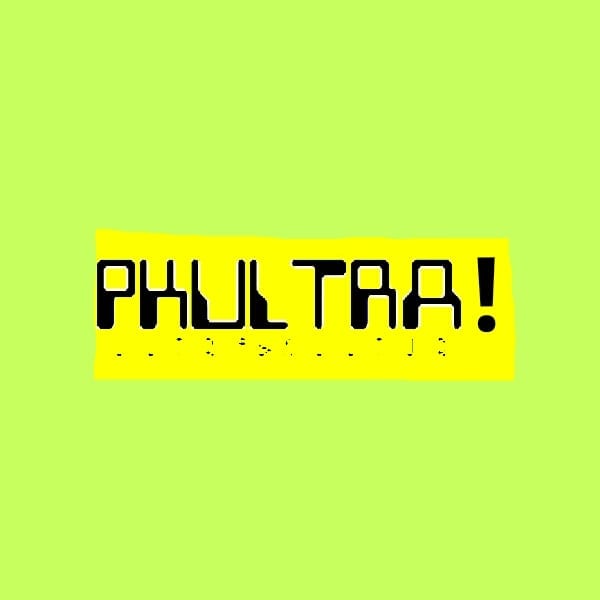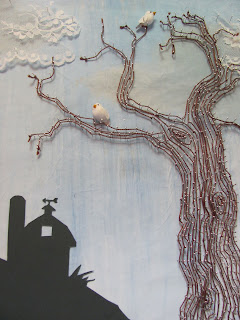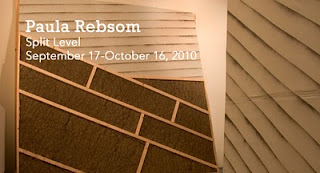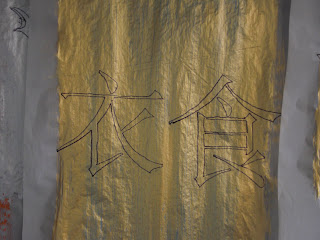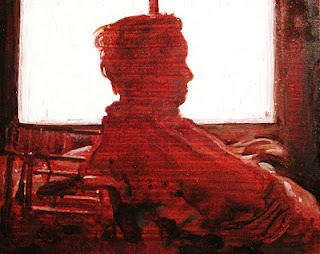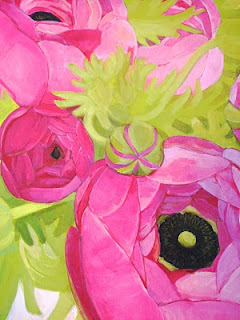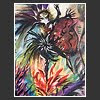
Form/Space Atelier Program for February 2010
Show Title: Trombones Bleu
Show Duration: February 12- March 7, 2010
Opening Reception February 12, 6PM as part of the Belltown ArtWalk
www.belltownartwalk.com
Matthew Kandegas exhibits his third and final solo show at
Form/Space Atelier. Kandegas moved to Vaasa, Finland January 1, to
join an intentional community of Suomi (Lapplanders) endeavoring to
re-establish Suomi customs, language and culture in an urban milieu (
http://en.wikipedia.org/wiki/Korsholm ). The community has built in
the city a lichen farm, which, as fodder, will sustain a herd of
caribou. Kandegas will retain representation by Form/Space Atelier at
the request of his collectors located in Seattle, though as of press
time, Kandegas was unable to say whether he would continue to create
new paintings while in Finland, but said the move to Scandinavia was
"permanent and irrevocable...".
Matthew Kandegas has been described as a Post-Minimalist painter,
his subjects have been figural in response to stadium rock, but in the
last decade he has created only images of paperclips. Curator Paul
Pauper discovered Kandegas during research for organizing a
performative spectacle exhibition of Kyle MacDonald at Form/Space
Atelier in November of 2007. MacDonald is an artist and author of One
Red Paperclip... , an account of MacDonald's success in trading 14
times from a simple paperclip to a two-bedroom house.
Form/Space Atelier donated a Kandegas painting from his series
Trombones Jeunes to Strangercrombie 2009, his work is also in the
collections of MacDonald, Lindsey Daniel, The Low Income Housing
Institute, Cascade People's Center and several other charitable
organizations.
Trombones Bleu translated from the French is blue paperclips, the
paintings exhibited are the latest series which began with Trombones
Rouge (red paperclips) followed by Trombones Jeune (yellow
paperclips). Trombones Bleu are oil on panel, mostly large scale (4
feet by 9 feet) oriented portrait. The panels constructed by Kandegas
for the paintings are reclaimed 1970's-era basement rumpus room
paneling which had been slated for a landfill by Kandegas'
ex-girlfriend's mother. The composition of the panels is mahoghany, or
more precisely shorea. Shorea is a genus of about 196 species of
mainly rainforest trees in the family Dipterocarpaceae. The genus is
named after Sir John Shore, the Governor-General of the British East
India Company, 1793-1798. They are native to southeast Asia, from
Northern India to Malaysia, Indonesia and the Philippines. In west
Malesia and the Philippines this genus dominates the skyline of the
tropical forests. The tallest documented tropical angiosperm is a 88.3
m tall Shorea faguetiana in the Tawau Hills National Park, in Sabah on
the island of Borneo, and in that park at least 5 other species of the
genus have been measured to be over 80 m tall: S. argentifolia, S.
gibbosa, S. johorensis, S. smithiana and S. superba. Borneo is also
the hotspot ofShorea diversity with 138 species, of which 91 are
endemic to the island. One hundred and forty eight species of Shorea
are currently listed on the IUCN Redlist. The majority of which are
listed as being critically endangered. Most all of the Shorea
Mahoghany has been logged using elephants and Matthew Kandegas reveres
the wise leviathans that elephants are. Consequently, he valued very
highly the 1970's-era rumpus room panelling that his ex-girlfriend's
mother was going to take to a landfill, and immediately rescued the
wood which had been, through the insurmountable agony of an elephant,
been delivered to the 1970's-era oblivious ones seeking to remain
status-quo with their bridge-and-tunnel neighbors. Kandegas feels the
mahogany must live on, with a new purpose, that being to punctuate the
art object he was creating, defining the rescued wood as would a vegan
pointing to a trophy head on a hunters wall. Paper comes from trees.
Paperclips are the steel fetters on the trees children, paper.
Handcuffs on the babies of mighty larch.
The current level of exploitation for trade is not sustainable, and
current forestry practices may be harmful to the survival of the
species. And even low levels of mahogany harvest can be problematic
because of the secondary effects of logging enterprises: they create
roads that provide access to farmers and migrants who clear the forest
for agriculture. Finally, conservationists are concerned about
big-leaf mahogany because Honduran mahogany (S. humilis) and Caribbean
mahogany (S. mahagoni) already have been over-harvested and are now
considered commercially exhausted.
Currently, mahogany populations are in decline in every range
state. Many scientists feel that big-leaf mahogany is at risk of
suffering the same fate as Caribbean and Honduran mahogany if trade in
the species is not more carefully regulated, and if forest management
techniques are not significantly improved. The Brazilian Botanical
Society and the Brazilian Institute of Environmental and Renewable
Natural Resources have both listed S. macrophylla as endangered.
IUCN-The World Conservation Union lists the species as vulnerable.
Mahogany has been popular for centuries. With a well-established
reputation on the international market for beauty and durability,
mahogany is traded worldwide as sawn wood, in plywood, as veneer, and
as finished furniture products. The hardness and deep reddish-brown
color of the wood make it a popular material for furniture, inlays,
veneers, and musical instruments.
At the 12th Conference of the Parties to the Convention on
International Trade in Endangered Species of Wild Fauna and Flora
(CITES) in November 2002, big-leaf mahogany was listed on Appendix II
of the convention. CITES is an international treaty, with more than
160 signatory nations, that regulates international wildlife trade.
Under the provisions of Appendix II, international trade is strictly
regulated - an exporting state must determine that any big-leaf
mahogany (including logs, sawn wood, veneer sheets, and plywood) has
been legally obtained and that harvest was not detrimental to the
survival of the species; only then can a CITES export permit be
issued. States importing the products must not accept shipments that
are not accompanied by a CITES permit issued by the exporting country.
Prior to the listing of big-leaf mahogany on CITES Appendix II,
the mahogany trade was to be conducted according CITES Appendix III,
on which it was previously listed by Bolivia, Brazil, Colombia, Costa
Rica, Mexico, and Peru. Evidence exists, however, that much of the
trade was not in compliance. Disparities in trade data - importing
countries reporting more mahogany imports than exporting countries
declared - indicate that there may be substantial illegal logging and
trading of mahogany. Illegally logged mahogany is exported out of
range states without proper CITES certification, and is almost
certainly harvested at levels that are unsustainable.
There is also evidence that mahogany is being harvested in
violation of local timber regulations, particularly in Brazil and
Peru, the world's largest exporters of mahogany. Mahogany is being
harvested from lands belonging to indigenous peoples, in violation of
Brazilian and Peruvian law. Recent press reports indicate that in some
cases indigenous groups are allowing illegal logging on their lands
and charging a premium to the loggers. In other cases, loggers
manipulate the indigenous groups into giving up their hardwood.
Conservationists estimate that more than half of the mahogany coming
out of Brazil and Peru may have been extracted from indigenous lands.
Until recently, the United States and the United Kingdom were by
far the largest importers of mahogany, together importing 80 percent
of the world's mahogany in trade. In the early 1990s, a consumer
boycott of mahogany in the United Kingdom drastically reduced that
country's share of the mahogany trade; however, the United States has
increased imports in recent years and made up the difference. Other
importing nations include the Dominican Republic, Argentina, Mexico,
Puerto Rico, Venezuela, Canada, France, Germany, the Netherlands,
Spain, Finland, South Africa, and Saudi Arabia. A great deal of
mahogany is also consumed domestically by the range states and, in
addition, range states trade mahogany with each other.
Between 1992 and 1998, the United States imported an average of
80,000 cubic meters of mahogany every year. Between 1989 and 1995, a
similar period, global mahogany trade averaged 111,000 cubic meters
per year. U.S. imports of mahogany account for the majority - nearly
60 percent - of total global trade. Most of the mahogany imported into
the United States comes from Brazil, with Peru and Bolivia important
secondary sources.
Because the United States is the world's largest consumer of
mahogany, U.S. consumers can play a powerful role in protecting the
species from over-harvesting, by purchasing only those timber and
mahogany items that have been "green-certified" by an organization
such as the Forest Stewardship Council. Certified timber has been
harvested in a sustainable and legal manner, with minimal destruction
to surrounding forests. By purchasing only sustainably harvested wood,
consumers can help prevent big-leaf mahogany from suffering the same
fate as Caribbean and Honduran mahogany.

 John Monson, Bed VII, 2010
John Monson, Bed VII, 2010